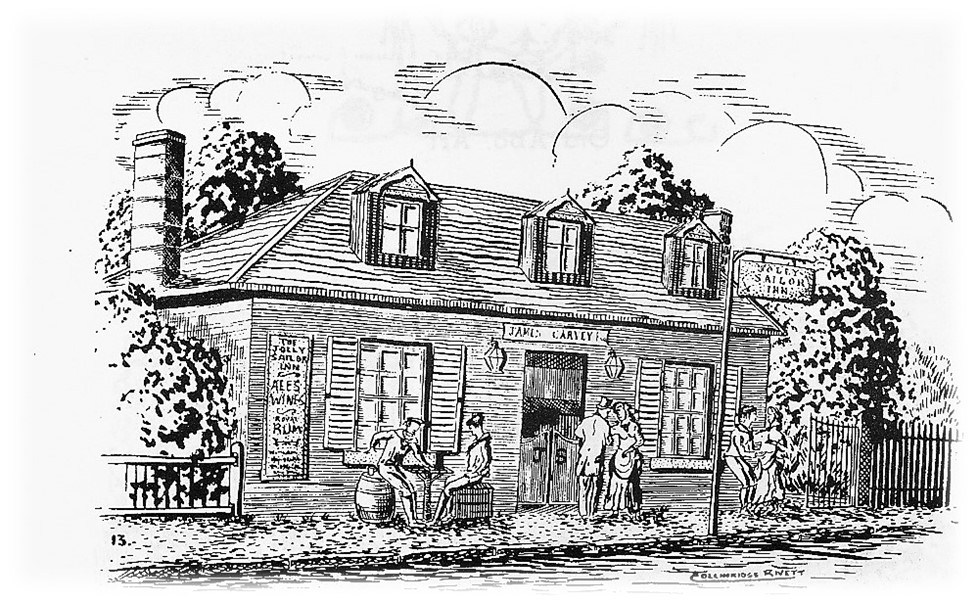THE Albion Hotel, once known as Annie’s (down by the Gasworks Bridge) is due to be replaced with two 51 storey, multi-story apartment buildings, with a token wine bar.
This location was the heartland of the river shipping trade in the 1800s and many Inns flourished.
William Sherwin (1763 – 1822) arrived on the ship Pitt in 1792. He was a sergeant with the NSW Corps. He became a land holder, a storekeeper, a chief constable, and a publican.
Between 1794 to 1810 William Sherwin and Corp associates ran Inns. One, possibly known as ‘The Crown’, was adjacent to today’s Gas Works Bridge, in George St. Parramatta, across the road from the Soldiers Barracks. The Soldiers’ District in the newly settled Parramatta (Rose Hill) was first established around 1790.
By 1810 Sherwin was Chief Constable in Parramatta and was living with Mary Duggan. They had 10 children up until 1822.
One of their sons was in later years a well-known Parramatta doctor, Dr William Sherwin, who answered the request of a large list of influential Parramatta folk to practise in his hometown. In the late 1820’s Parramatta was desperate for private medical help.
Sherwin’s Inn would have been purpose built for serving drinks from their front parlour, with living accommodation at the rear.
Convict made bricks for flooring, Iron bark timber frame, bark shingles on the roof. Sherwin cohabited on this site with Mary Duggan. He did not marry Mary because he had a wife, Ann, in England.
In a sad tale of infidelity, Ann was heading to Sydney to be reunited with William in 1808. Joseph Foveaux, who was to be William’s Captain, was returning on the same ship. On board, Ann and Foveaux became an item. Foveaux had a history for his unpleasant dealings with convicts on Norfolk Island, but he was an efficient administrator.
On returning to Sydney the Rum Rebellion was in full swing, and Governor Bligh was outed. Foveaux took control as Lieutenant-Governor of NSW, for a short time.
An obvious animosity
Despite the obvious animosity that existed between Sherwin and Foveaux, Sherwin went on to be a successful pioneer. He had other land grants and is credited with growing the first oranges in Australia.
The Ellison family had land grants west of the site of today’s Albion Hotel. William Sherwin’s land grant was one allotment west of Howell’s Mill, it was directly opposite the Ellison sites.
Both these men were associated with early inns in this area. John Ellison was licensee of the Bird in the Hand in George Street from 1815 to 1850. In 1829 he was also the owner of The Jolly Sailor Inn, on land opposite todays Albion Hotel, possibly on the same site as Sherwin’s original Inn.
From 1840 to the 1860s the mine hosts were James Garvey, then George Caines. Caines was from Bristol, a family of notorious criminals, who coincidentally ran a Jolly Sailor Inn in Hanham England. Around 1863 he received a notice to quit the Ellison Inn.
He then leased the land on the opposite side of the road. He was not allowed to take the Jolly Sailor name with him, so he called his new hostelry the Sailor’s Return. George held this license until 1872.
On the May 4th, 1882 Charles Abel, a dairyman of Parramatta, conveyed the Sailor’s Return land to a James Caines (son of George), also an innkeeper in Parramatta, for £1,000. Abel’s father had previously run the Sailor’s Return. James Caines developed the site on the corner of Harris and George Streets, as the Albion Hotel in 1882.
On 19th July 1924, the local newspaper reported that the historic Albion Hotel had recently been demolished to build another new Albion Hotel. The cottage next door, possibly the old Sailor’s Return, was used as a temporary bar.
The Albion Hotel is not just another hotel, its site history is an intrinsic part of the Parramatta story, and as such, she does not go quietly into the sunset. Like with our famous Royal Oak, we are slowly losing the soul of this city.
From the book ‘About that Shout’ By Gary J Carter. Available at Parramatta City Council Heritage Centre
By GARY CARTER
Image: Etchings courtesy of Collinridge Rivett’s family and Parramatta Press 1956. Picture from Parramatta Heritage collection





